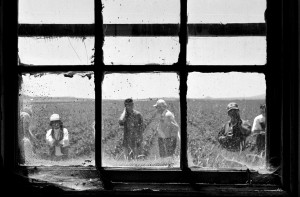Events
 Cornell University Library
Cornell University Library
The Rare and Manuscript Division will create a display of artifacts drawn from its unique and rare holdings in Kroch Library, especially from the collection of Japanese American Relocation Centers Records. The exhibition will be installed in the Olin/Kroch transit corridor and in the “rotunda” gallery at the entrance of the Rare and Manuscript Division (Kroch Library level 2B). It will remain on view between August 22 and September 27, 2013.
The Cornell University Library will create a display of artifacts drawn from our unique and rare holdings in Kroch Library, especially from our collection of Japanese American relocation centers records. The exhibition will be installed in the Olin/Kroch transit corridor and in the “rotunda” gallery at the entrance of the Rare and Manuscript Division (Kroch Library level 2B). It will remain on view between August 22 and September 27.
 The Johnson Museum
The Johnson Museum
The Johnson Museum will present a public talk at the Museum on Thursday 19 September at 5:15 pm by artist Roger Shimomura. Shimomura’s work revolves around sociopolitical issues of ethnicity where he addresses his and his family’s experience at Minidoka Relocation Center, as well as his own experiences of racial and ethnic discrimination, even though he is a third generation American. The artist views his work not only as recording what happened in the past but as a metaphor of our nation’s continuing reactions whenever there are perceived threats to our way of life. The public is invited.
 Eyewitness: Stan Honda – Reflections of a Photojournalist
Eyewitness: Stan Honda – Reflections of a Photojournalist
The Tatkon Center is hosting an exhibit of the works of Stan Honda, a professional photographer for 31 years. He discovered his passion for photography in college and, although, his parents thought photography an odd profession, they encouraged him to do whatever he wanted to do. Stan kept taking photos and now his photos grace the covers of major publications around the world. In this exhibit, we show four groups of photos. Three groups are Stan’s on-the-job photos taken on assignment for Agence France-Presse, for whom Stan is a staff photographer. The fourth group is a “personal” project, equally important.
The Agence France-Presse photos include Stan’s iconic photos of September 11, 2001 (9/11), the aftermath of Hurricane Katrina, and the war in Iraq. When Stan was assigned to cover “the story” of Hurricane Katrina, he covered an “other story” – the largely untold story about two Vietnamese communities, one of shrimpers and casino workers in the Gulf Coast of Mississippi, and the other of evacuees from New Orleans who relocated to Houston. In Houston, Mr. Honda visited a Catholic convent of Vietnamese-American sisters who had taken in over 250 evacuees. Some of them were Vietnamese-Americans who were originally refugees from Vietnam. They described the Hurricane Katrina experience as being “refugees for the second time.” The exhibit includes a number of photos from the convent.
For almost 15 years, Stan has been photographing another “other story” of a community displaced, and worse – the rounding up and confinement of people of Japanese ancestry, most of them U.S. citizens, in ten internment camps in the U.S. during World War II. This is the personal project, although these photos, too, have been published and exhibited widely and here, too, the personal is political. Stan is a Sansei, a third-generation Japanese-American. His parents were incarcerated at the Poston, Arizona camp – the second largest city in Arizona at that time. The government created Poston on land taken from the Colorado River Indian Tribes’ reservation. The photographs here are of some of the ten internment camps and of the Heart Mountain Barracks Project. In 1994, a group of volunteers dismantled two barracks from the Heart Mountain camp in Cody, Wyoming, to preserve them.
In mounting this exhibit, we purposely placed the photographs of 9/11 and the photographs of the internment camps side-by-side. Through this juxtaposition, Stan provides a historical context to the “War on Terror,” relating the aftermath of 9/11 to the unconstitutional incarceration by the U.S. government of Japanese Americans during World War II. Of course, all of the groups of photos are connected – Iraq to 9/11 and even Katrina to the camps. In all of the photos, too, Stan is an eyewitness to major events of the twentieth century.

